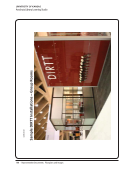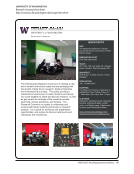44 · Survey Results: Survey Questions and Responses
Hope to make the Kenan Science Library a center for high-end e-science applications, but this has not yet been
developed to any significant degree.
In a small way we have continued to add to the variety of electronic devices that we circulate, this allowed us to create a
separate service point only for devices.
In general, the Transition to Online program (last eight years) has enabled staff to provide reference services virtually/
online and has allowed users to find many materials online and perhaps more independently, i.e., these materials no
longer have to be housed in a space adjacent to the desks. In addition, services can be provided remotely through other
social media/software so librarians don’t need to be scheduled on the desk as much. Remotely through Meebo/Screenr/
email.
Increased digital resources made having an onsite collection of printed materials less of an imperative.
IS&T used thin client technology to install 200 computer stations over three floors in the library and removed their
outdated PC-based basement computer lab with 128 computers elsewhere on campus and 48 PCs in the library drove
the opportunity to reconfigure service points. The library used a subscription to appointment.com to provide web-based,
student-initiated appointments with librarians, including text description of need.
LibraryH3lp as first line of answer after experiment with Meebo had partial results due to lack of continuous hours.
LibGuides enabled added layer of virtual presence.
Multi-media technology and new equipment were added to a more traditional information commons area.
New audio and media technology allowed us to serve users more efficiently and the new space supported this. And the
new space allowed us to enhance and improve the backroom functions that support direct users’ services.
Not sure if this can be considered “new technology” but the increase in online journal subscriptions had an impact on
the reconfiguration.
Providing better access to technology for students has been an important goal in changes to service delivery. The
move to the provision of applications via the cloud by our central IT department has meant that laptops are even
more pervasive and places to sit, work, collaborate, and recharge are essential. This has informed the redesign of
our reconfigured spaces and the purchase of furniture and equipment. We are beginning to use mobile technology
for service delivery as well. Presentation practice spaces and videoconferencing were also introduced to support
instructional programs.
The availability of online content is not new or emerging, but it was a factor in the space configuration described above.
The downward trends in circulation patterns was a major factor in our decision making, coupled with the advances in
self-service options and the expectation for these user enhancements i.e., self sign out/in and fines payments.
The establishment of the virtual service point was facilitated through greater use of RSS feeds, LibGuides, and Moodle
course management software.
The new configuration allowed for time to implement new technologies. Skype enabled consultations without having to
meet face-to-face. Use of online tutorials and web pages increased. They are transitioning to cloud computing. Services
are moving from face-to-face to online.
The only technology impact on this decision was the ability to provide significant amounts of current and archived health
sciences literature electronically.
The significance of the impact is unknown, but there is a new department devoted to the exploration of many of these
aspects, which is our User Experience department. This group is working with and offering instruction sessions to
Hope to make the Kenan Science Library a center for high-end e-science applications, but this has not yet been
developed to any significant degree.
In a small way we have continued to add to the variety of electronic devices that we circulate, this allowed us to create a
separate service point only for devices.
In general, the Transition to Online program (last eight years) has enabled staff to provide reference services virtually/
online and has allowed users to find many materials online and perhaps more independently, i.e., these materials no
longer have to be housed in a space adjacent to the desks. In addition, services can be provided remotely through other
social media/software so librarians don’t need to be scheduled on the desk as much. Remotely through Meebo/Screenr/
email.
Increased digital resources made having an onsite collection of printed materials less of an imperative.
IS&T used thin client technology to install 200 computer stations over three floors in the library and removed their
outdated PC-based basement computer lab with 128 computers elsewhere on campus and 48 PCs in the library drove
the opportunity to reconfigure service points. The library used a subscription to appointment.com to provide web-based,
student-initiated appointments with librarians, including text description of need.
LibraryH3lp as first line of answer after experiment with Meebo had partial results due to lack of continuous hours.
LibGuides enabled added layer of virtual presence.
Multi-media technology and new equipment were added to a more traditional information commons area.
New audio and media technology allowed us to serve users more efficiently and the new space supported this. And the
new space allowed us to enhance and improve the backroom functions that support direct users’ services.
Not sure if this can be considered “new technology” but the increase in online journal subscriptions had an impact on
the reconfiguration.
Providing better access to technology for students has been an important goal in changes to service delivery. The
move to the provision of applications via the cloud by our central IT department has meant that laptops are even
more pervasive and places to sit, work, collaborate, and recharge are essential. This has informed the redesign of
our reconfigured spaces and the purchase of furniture and equipment. We are beginning to use mobile technology
for service delivery as well. Presentation practice spaces and videoconferencing were also introduced to support
instructional programs.
The availability of online content is not new or emerging, but it was a factor in the space configuration described above.
The downward trends in circulation patterns was a major factor in our decision making, coupled with the advances in
self-service options and the expectation for these user enhancements i.e., self sign out/in and fines payments.
The establishment of the virtual service point was facilitated through greater use of RSS feeds, LibGuides, and Moodle
course management software.
The new configuration allowed for time to implement new technologies. Skype enabled consultations without having to
meet face-to-face. Use of online tutorials and web pages increased. They are transitioning to cloud computing. Services
are moving from face-to-face to online.
The only technology impact on this decision was the ability to provide significant amounts of current and archived health
sciences literature electronically.
The significance of the impact is unknown, but there is a new department devoted to the exploration of many of these
aspects, which is our User Experience department. This group is working with and offering instruction sessions to






















































































































































































































